When planning on a quarantine tank to use during our recent rescape, I needed to come up with a way to provide aeration (oxygen) and filtration for our critters. I didn’t want to spend much money and wanted something simple. The best solution I came up with was a sponge filter.
The sponge filter worked great for our use in the temporary tank. For many aquarist, it might just be the perfect filter based on some of the unique advantages of sponge filters.
How Does a Sponge Filter Work:
Sponge filters, like the Xinyou model that I am reviewing, all work using similar principles. The sponge filter uses an air line fitting that releases air into a lift tube. The upward flow of air bubbles in the lift tube draws water upwards.
I wish I could explain the principles behind how it works (Bernoulli’s principle, venturi pump?). The bottom line is that the air flowing upwards in the tube creates low pressure at the base of the lift tube, and this sucks water through the media.
Sponge filters offer two kinds of filtration. First, they provide mechanical filtration. The sponge media traps detritus and other solids. Second, the high surface area of the sponge’s external and internal structure gives plenty of room for good bacteria to grow and thus provides biological filtration.
Sponge filters only lack chemical filtration, like what is supplied by activated carbon.
Benefits and Disadvantages of a Sponge Filter:
I can think of a few areas where sponge filters really shine:
- Simple and inexpensive – you do have the cost of an air pump and hose that needs to be taken into consideration, but the filter itself is very cost effective, even if you are needing to use several in an aquarium.
- Good aeration – the addition of bubbles flowing up the lift tube and into the aquarium adds oxygen to the tank.
- Surface disturbance – Depending on the height you set your sponge filter and the height of the lift tube, you can set the outlet of water / bubbles to be right at the surface of the water. This disturbance at the surface can help break up surface scum, which makes for a more attractive tank and facilitates gas exchange in the aquarium.
- Safe for small fish fry or shrimp – breeders are big proponents of sponge filters. Unlike other filters such as drip systems or canister filters that incorporate pumps, sponge filters do not harm small critters in any way. The sponge filter pores are too small for even the tiniest of animals to get sucked in.
- Gentle water flow – If you set the outlet pipe to discharge back into the glass of the aquarium, flow inside the tank is very gentle. Great for fish and shrimp fry, but also good for fish that are easily buffeted by currents, such as beta fish.
Some of the shortfalls of using sponge filters:
- Aesthetics – sponge filters are not all that attractive. In a larger tank, they can be disguised and hidden behind decorations or plants. In a nano aquarium, they tend to stand out.
- Use of an air pump – I find this a weakness only in that air pumps are inefficient and loud. The noise issue can be mitigated if you are careful to select a high quality air pump and can house it separately to dissipate some of the noise. Having said that, aside from the sound of the air pump, sponge filters themselves are reasonably quiet with the only noise being from the flow of upward bubbles.
- Filtration capacity – For larger aquariums with a high bioload, it may be challenging to get enough filtration from sponge filters alone.
Xinyou XY-2830 Sponge Filter Review:
For the needs of a nano aquarium or a small quarantine tank like our 5 gallon (18.9 Liter), the Xinyou model XY-2830 works very well. It is good for filtering small tanks of less than around 10 gallons (37.9 Liters). It is smaller than some sponge filters that have dual sponges as it has only one sponge paired with the one lift tube.
The sponge filter comes with packaging with instructions not in my native english tongue. Luckily, the unit is simple enough to figure out.
I paired it with a Tetra Whisper (10 gallon model) air pump and a few feet of aquarium air hose. I wanted to get the sponge seeded with beneficial bacteria prior to our rescape, so I set the filter up a few weeks prior at the end of our Spec V Aquarium.
The sponge filter has a single suction cup for attaching to the tank’s glass. The lift tube is segmented with a larger diameter bottom part and a smaller diameter upper; the two pieces can telescope inside one another to adjust the height of the lift tube relative to the sponge.
I setup the sponge filter about halfway up the wall of the aquarium and adjusted the height of the lift tube to discharge almost at the surface of the water. The discharge from the filter is at a 90º angle from the tube so the resulting water flow is parallel to the surface. You can rotate this discharge elbow to direct the water flow in any direction. I chose to rotate it to discharge back into the glass. I tried it discharging straight into the display tank, but the flow seemed a bit high for our fish.
To complete the setup, just connect a piece of air hose from the air pump to the connection at the side of the sponge filter. Turn the air pump on, and you are set.
Here are some dimensions that I took from the XY-2830:
- Mounted Depth (distance from glass): 2-1/8″ (55 mm)
- Width: 3-5/16″ (85 mm)
- Total Height Minimum (with lift tube at lowest position): 5-1/2″ (140 mm)
- Total Height Maximum (with lift tube at highest position: 7-1/16″ (180 mm)
The filter worked great. It’s not apparent how much detris it is removing from the tank as the sponge appears clean even after weeks of use. After two weeks, I rinsed it out and the amount of dirt that came out was impressive. Rinse water that dirty means the filter was doing it’s job to keep the tank clean.
How to Clean a Sponge Filter:
It is very easy to clean a sponge filter, but you need to keep in mind one simple rule. Do not use tap water to rinse out your sponge filter if you want to keep it in use. Tap water containing chlorine will kill the beneficial bacteria that converts ammonia waste from your fish and shrimp to nitrite and then nitrate.
I would do the following to clean a sponge filter:
- Fill a separate container with old aquarium water or with tap water that has been declorinated with something equivalent of Seachem Prime.
- Remove the sponge filter from the aquarium. It will probably be easiest to keep the air hose attached and just stretch it over to your container of cleaning water.
- Hold the sponge filter over the cleaning water. Grasp the sponge filter media and pull it off.
- Put the sponge in the water and squeeze a few times. The detris and debris will come out of the sponge.
- Put the sponge back on the filter tube and put it all back in your aquarium.
Xinyou XY-2831 Sponge Filter – a Larger Alternative:
For those that have aquariums larger than 10 gallons and that want some additional filtration capacity, look into the Xinyou XY-2831. It is a sponge filter with the same design and basic concept as the smaller XY-2830, except that it has two sponge filters instead of one. I had considered it but decided it would be a bit large in a 5 gallon. For a 10 gallon or larger tank, it would be a great choice.
If you are setting up an even larger tank that needs additional filtration capacity, consider setting up multiple sponge filters. You can set them up on opposite ends of the aquarium or even have a line of multiple sponge filters along the back glass. The only thing you need for multiple sponge filters is extra air hose and additional air capacity. You can either purchase an air pump that has multiple outlets, or you can simply split a single outlet air pump into two air lines with a splitter of some sort.
Overall, I’m very impressed with the concept of sponge filters and am happy with the Xinyou line. The filters are very inexpensive but do a great job of keeping aquarium water clean.


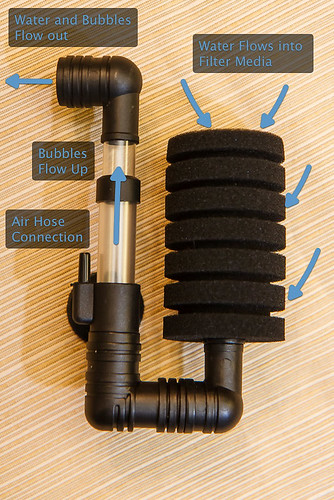
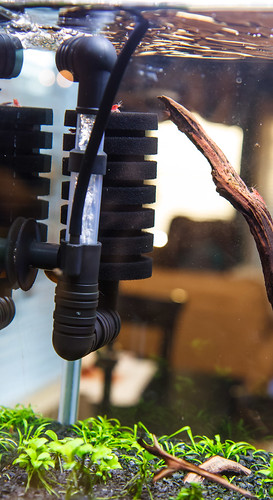
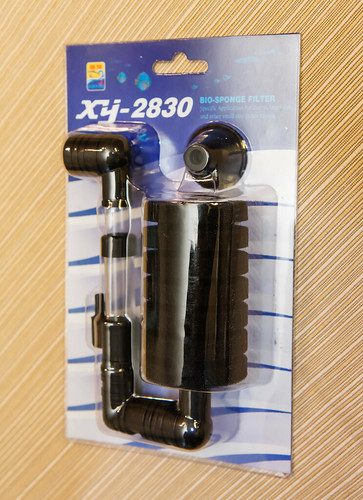
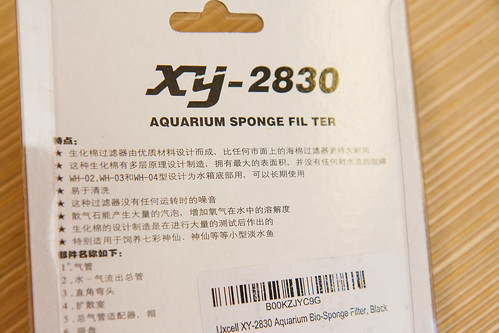
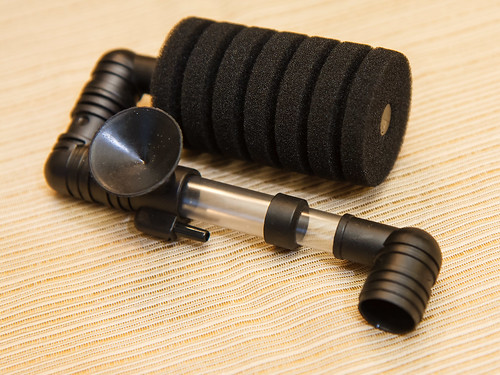
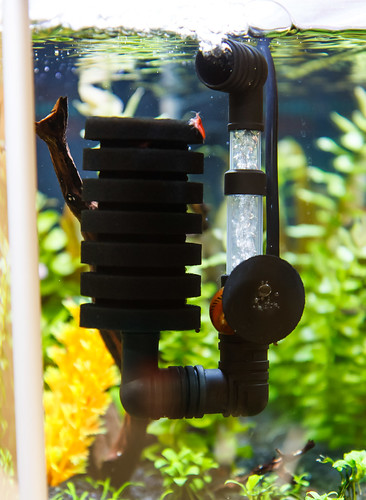
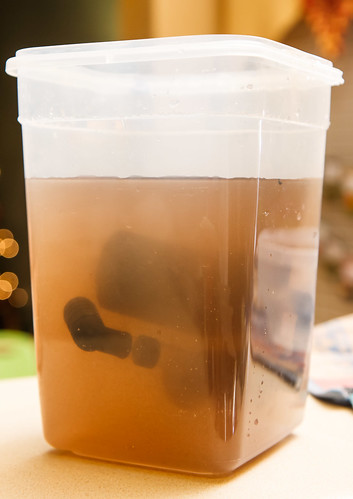
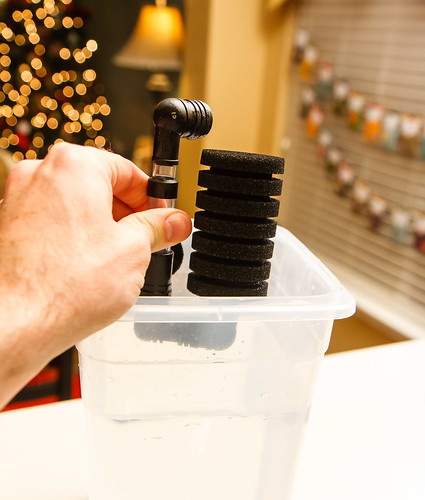
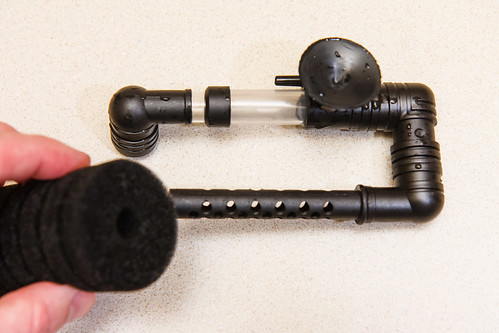
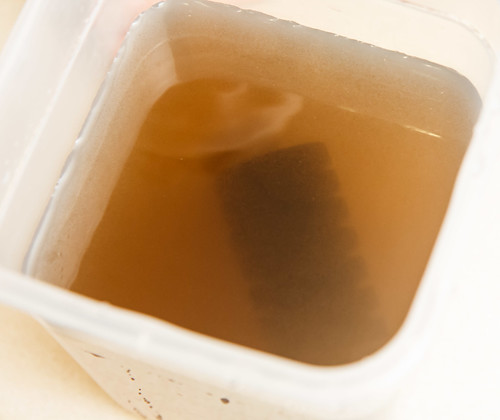

I bought the XY-2820 but it did not come with the pump to turn it on. Where and what is the pump I need to purchase that you would recommend? Thank you.
any air pump. like this one.
Nice article mate